|
|
Dear Colleagues,
When I was asked this January to write the editorial for PSI facility newsletter for the end of March, I thought I had accepted an easy task. SwissFEL had just completed a very successful first year of regular user operation and the second beamline of SwissFEL, Athos, had seen first light at the end of 2019. The future looked bright with the upcoming restart of the upgraded SINQ and preparation of the next large project at PSI, the upgrade from SLS to SLS 2.0, advancing fast.
|
 Hans Braun Hans Braun
|
|
In short, I had a simple listing of positive perspectives in mind for this text. With the outbreak of the coronavirus uncertainty has broken into the lives of people around the world. With severe restrictions on travel almost everywhere and priority on the health of our employees and visitors, the global network of researchers, used to move easily to the place where they can perform their experiments best, is suddenly brought to almost a standstill.
Although nobody can know what the next weeks and months will bring, we all hope that we will overcome this crisis and that the next editorial can give the positive outlook I had planned here.
Hans Braun
on behalf of the SLS 2.0 project team and PSI’s accelerator technology department
|
|
Impact of COVID-19 on PSI user operation
The worldwide spread of COVID-19 is still ongoing and - of course - also seriously affects the user operation at our large-scale facilities. On the other hand, PSI’s facilities provide unique characterization techniques to efficiently and promptly support these needs. Further, our interdisciplinary teams comprising physicists, molecular and structural biologists, chemists and
|
 courtesy of imago images / Science Photo Library courtesy of imago images / Science Photo Library
|
|
|
beamline scientists are ready to assist with their expertise. Please find a list of links with some useful information related to the topic below:
As you know, the situation is moving fast and is hardly predictable. We will try to keep you informed. Please visit the User Office Homepage for the latest updates.
|
|
Next proposal submission deadlines:
SLS: PX beamlines
deadline: April 15, 2020
more information
SLS: non-PX beamlines
deadline: September 15, 2020
more information
SwissFEL
deadline: September 15, 2020
more information
SµS
deadline: tba
more information
SINQ
deadline: tba
more information
Particle Physics
deadline: January 11, 2021
more information
An overview of all proposal submission deadlines of the PSI facilities can be found here.
|
|
|
Soft X-ray laminography of thin specimens
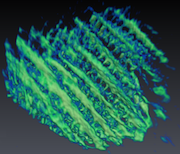 SLS - 3D imaging with powerful contrast mechanisms SLS - 3D imaging with powerful contrast mechanisms
With the implementation of a new soft X-ray 3D imaging technique at the PolLux beamline, a versatile new tool has become available at SLS for studying thin extended specimens in the energy range of 270–1500 eV. Soft X-ray Laminography (SoXL) combines the advantages of laminography — a tomographic approach where a tilted rotation axis enables large-area nm-resolution imaging of flat samples — with the clear contrast characteristic of soft X-ray imaging. Exploring the new capabilities, the SLS researchers worked with scientists from Germany and the UK to produce striking images of samples ranging from functionalized nanomaterials and biological photonic crystals (pictured is the reconstructed 3D model of the tip of a butterfly-wing scale) to complex magnetic materials. SoXL is running as a standard operation tool at the PolLux beamline and is now available for user operation.
Read the full story
|
|
|
K. Witte et al., Nano Letters 20, 1305 (2020)
|
|
|
A quantum liquid of magnetic octupoles on the pyrochlore lattice
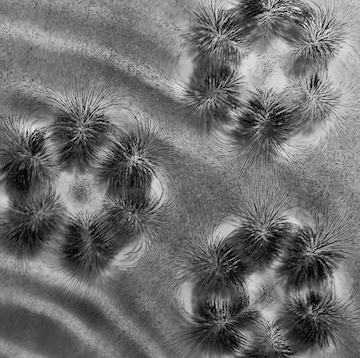
SINQ - Spin ice expands to higher orders
With experimental work demonstrating that the correlated ground state of the pyrochlore system Ce2Sn2O7 is a quantum liquid of magnetic octupoles, a team led by PSI scientists established a fundamentally new state of matter: higher-rank multipole ice. Their work extends the concept of spin-ice materials, where magnetic moments are subjected to frustrated interactions that leave the system disordered down to zero temperature, in direct analogy to proton disorder in water ice. Now for the first time a magnetic ice state has been discovered that is formed not by dipoles, but by higher-rank degrees of freedom, octupoles. Intriguingly, the dominant interaction in this system was found to be octupole–octupole coupling, making Ce2Sn2O7 one of only a handful of materials where phases are driven primarily by higher multipolar interactions — and a unique example of a quantum liquid among them.
Read the full story
|
|
|
R. Sibille et al., Nature Physics, 23 March 2020 (online)
|
|
|
Tunable anomalous Hall conductivity through volume-wise magnetic competition in a topological kagome magnet
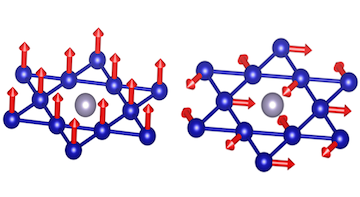
SμS - A link between quantum magnetism and electronic band topology
An international team led by PSI scientists has identified a quantitative link between the magnetic and topological electronic properties of the kagome magnet Co3Sn2S2. Through muon spin rotation experiments, combined with ARPES and neutron-diffraction data, they discovered two competing magnetic orders in the kagome lattice of this compound, one ferromagnetic out-of-plane order and the other in-plane antiferromagnetic order. A close correlation between the ferromagnetic volume fraction and anomalous Hall conductivity suggests that magnetic and topological electronic properties are closely linked in this system. As the competition between the two magnetic phases can be tuned both by applying external magnetic fields and by exerting hydrostatic pressure, these findings offer the exciting prospect of a unique platform for exploring the rich physics emerging from the interplay of topological band structures and quantum magnetism.
Read the full story
|
|
|
Z. Guguchia et al., Nature Communications 11, 559 (2020)
|
|
|
First lasing at new beamline
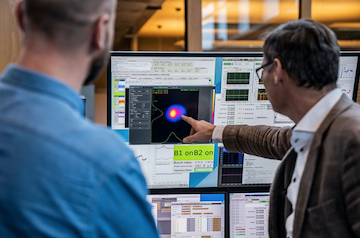 SwissFEL - Athos is making great strides SwissFEL - Athos is making great strides
The new soft X-ray beamline Athos at SwissFEL has produced its first laser beam. On December 17, 2019, the Athos team watched as the diffuse X-ray light got focused into a characteristic compact spot, signalling lasing (pictured). The achievement came on the first attempt, and earlier than expected. With this milestone passed, the Athos project is well on its way to getting ready for users. The first experimental station, Maloja, is scheduled to be ready in April and should go into operation by the end of the year - although the current pandemic is expected to lead to delays. Athos will eventually deliver laser light in the photon-energy range of 0.25–1.9 keV (6.5–50 Å). With this, the new beamline will complement the hard X-ray line Aramis (2.0–12.4 keV; 1–6 Å), which has provided photon pulses to users since the end of 2017 and with which Athos will operate in parallel.
Read the full story |
|
Measurement of the permanent electric dipole moment of the neutron
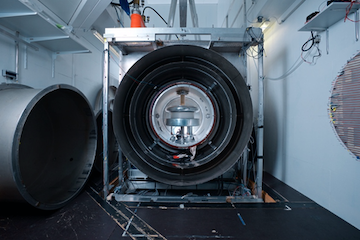 Particle Physics - Tracking down the mystery of matter Particle Physics - Tracking down the mystery of matter
A collaboration of researchers from 18 institutes and universities across Europe and the US have presented the most precise measurement yet of the neutron electric dipole moment (nEDM), one of the most sensitive probes of CP-violating physics beyond the Standard Model. The new upper limit is the result of analysing 54,068 individual measurement cycles, which were performed in 2015 and 2016 at PSI’s ultracold neutron source (UCN). Two separate groups then worked on blinded datasets. An outstanding feature of these data is the unprecedented level of understanding of and control over errors arising from magnetic-field changes. Building on the experience gained, the team is now in the process of constructing the next-generation experiment at PSI, dubbed n2EDM, which should provide an order-of-magnitude improvement in the next series of nEDM measurements. These are due to start in 2021.
Read the full story
|
|
|
C. Abel et al., Physical Review Letters 124, 081803 (2020)
|
|
|
Operando X-ray diffraction during laser 3D printing
SLS
The PEM (Photons for Engineering and Manufacturing) group at PSI has built a miniaturized device for selective laser melting (SLM) that can produce 3D structures while performing ultra-fast time-resolved X-ray diffraction experiments. SLM is an additive manufacturing process that uses a high power-density laser to selectively melt and fuse powders spread layer by layer. The newly developed MiniSLM device provides new capabilities for establishing the often not well-known relationship between the numerous processing parameters and the final microstructure produced, as demonstrated in a series of operando experiments on the commercial alloy Ti-6Al-4V.
More info |
|
SINQ proposal round I-20
SINQ
The first proposal submission deadline after the SINQ guide upgrade was on January 31, 2020. The call was open for 9 instruments. We received a remarkably high number of 204 new proposals for those instruments. The proposals are presently under evaluation and we will inform the users about the result as soon as possible.
Because of the present coronavirus situation, preparations for the startup of the proton accelerator HIPA are currently suspended, at least until April 19. This may lead to a delay of the planned start of SINQ user operation and might also affect the SINQ user program. At the moment, the situation is quickly evolving and we cannot make definite statements about the start of the user program and the consequences for the schedule of the experiments. We will provide updated information as soon as it will become available. |
|
Progress report on the FLAME project
SμS
The new μSR user facility instrument FLAME (FLexible and Advanced MuSR Environment) is under construction. In 2019, part of the infrastructure such as a new local area crane, a permanent liquid nitrogen supply, a vacuum control system, an extended gallery for the electronic racks and a new experimental hutch were installed. The detector system based on silicon photomultiplier technology is ready for testing in the beam. The design of the magnet system with an outer dry high-homogeneity superconducting 3.5 T magnet and an inner vector magnet for zero field compensation and weak transvers field experiments was finalized and the magnet is in production. To guarantee fail-safe operation of the superconducting magnet, FLAME will be equipped with emergency power and an emergency cooling water system for the compressors of the pulse tube coolers. The delivery of the 4He cryostat is foreseen for April and of the dilution fridge insert for September 2020. A vertical movement system for the cryostats to position the sample in the beam is in production. Testing and expert user experiments are foreseen for the first half of 2021 and user operation at FLAME is planned for the second beam period of 2021.
|
|
ATHOS: on the home stretch
SwissFEL
Having passed the milestone of first lasing (see the Research Highlight above), the Athos project at SwissFEL has now entered the home stretch. For the successful run of December 17, 2019, two undulators and one chicane between them were in operation. Ultimately the electrons will pass through 16 undulators alternating with 15 chicanes. With the incorporation of small magnetic chicanes after every undulator segment, the Athos layout differs from most existing FELs. The chicanes enable manipulating the electron bunch to optimize the lasing process and to improve specific properties of the FEL light. The next milestone will be the arrival of the laser beam in the experimental station.
|
|
The 2020 user meeting for particle physics at PSI
Particle Physics
On January 27-29, 2020 LTP hosted the 51st BVR (“ Benutzer- Versammlung Ringexperimente”) meeting. On Monday, the international advisory committee performed half-day in-depth reviews of the four presently largest experiments MEG II, Mu3e, n2EDM and MUSE. Committee internal meetings during the mornings of Tuesday and Wednesday served the discussion of many requests for test beams, various progress reports of ongoing projects, the two new proposals in muon physics and a letter of intent for a new experiment at the UCN facility. Because of typical durations of particle physics experiments of 5-10 years, compared to other user facilities, the number of new proposals is naturally small. Therefore, it is worth mentioning that there were two new proposals and one letter of intent submitted to the committee this year. The open users’ meeting took place on Tuesday afternoon with about 100 participants listening to an update by the head of LTP, a theory overview by Ana Teixeira (Clermont Ferrand), and presentations of the new efforts and selected progress reports. The next BVR52 will take place January 25-27, 2021. |
|
JUSAP - The Joint Users Association
Dear colleagues,
The situation with the coronavirus in Switzerland, as in Europe, is currently serious. The Federal Council of Switzerland has declared an “extraordinary situation”. People are highly encouraged to stay at home and work from there, to curb the spread of the coronavirus. Visitors from high-risk countries face a restricted entrance into Switzerland. The situation evolves very quickly. Please visit the official webpage of the Swiss government to access the latest information on this.
|

Claude Monney
|
|
Recently, in response to the recommendation of the Swiss Government, PSI has decided to suspend external user operation at its facilities, starting March 17 until April 19, at least. More information is available here.
However, there is an exception and, as a reaction to the evolution of the coronavirus, a priority access call has been opened by PSI for short proposals and quick peer review to enable rapid access to beamtime at SLS. Please have a look at this webpage for more information.
Of course, all of these restrictions make our work and daily life more difficult, and slow down our research. It is essential now to stay in good health and make sure we get out of this crisis as well as possible.
However, we keep going and there are positive news. The Swiss Society for Photon Science (SSPh) was founded at the end of 2019. Its mission is to represent scientists active in the fields of optics, photonics and spectroscopy. You can now join the newly founded society SSPh to help shape the Swiss landscape for Swiss photon science and stay up to date with the strategy. To become a member, you can register on the following website. Together we will provide the currently missing input to the research roadmaps and strategic planning of photon science in Switzerland.
We encourage you, members of the PSI user community, to communicate to us any issues, concerns or suggestions. In this case, please contact us, committee members, directly.
Yours sincerely,
Claude Monney and Mirjam van Daalen on behalf of the JUSAP committee
|
|
|
|